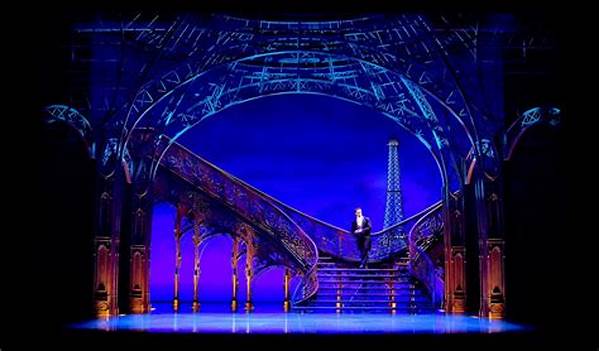Once upon a time on a bustling theater street where lights sparkled like stars, a whisper of awe danced through the air. Audiences entered grand auditoriums, not quite knowing the magical transformations awaiting them. Here, the bridge between technology and tradition formed anew. The magic carpet of digital set design in musicals was ready to take them on a journey beyond imagination.
Read Now : Unforgettable Chart-topping Band Singles
The Dawn of Digital Realities
In the heart of this enchanted realm, where tales of old met the innovations of today, digital set design in musicals began its remarkable journey. It started as a whisper, a curious idea by a few trailblazing creators who dared to dream of something beyond painted backdrops and scenic flats. It was more than a technical shift—it was a revolution in storytelling. Imagine a stage where the impossible became vividly tangible, where an ancient castle could emerge from the mist or a deep forest could whisper secrets with the sway of digital leaves. Here, digital technology was not just a tool; it was a new language of art, breathing life into static imagery, making it dance to the rhythm of storytelling.
As audiences were drawn into these new visual tales, their experience became richer, layered with the depth of dimensional storytelling. Set transitions were seamless, as entire worlds morphed before their eyes, drawing gasps and applause from houses filled with eager spectators. The interplay between actors and their digital surroundings blurred the lines between reality and imagination, creating an immersive experience that resonated with the heart and soul of theater. This era marked the dawn of digital set design in musicals—a time when the curtain rose not just on shows, but on infinite horizons of creative potential.
Weaving Tales with Digital Threads
In the theater’s sacred space, the digital set design in musicals wove its enchanting tapestries. Spectacular vistas appeared with a mere flicker, turning traditional stagecraft into a mystic art.
1. An evening sky, glowing with stars, morphed seamlessly into a dawn sun.
2. Digital forests breathed, alive with fluttering leaves and creatures that danced.
3. Urban landscapes pulsed with neon vibrance, echoing the heartbeat of bustling cities.
4. Magical castles emerged, formidable and grand, amidst swirling digital mists.
5. Oceans roared and crashed, their digital waves touching audiences like whispered secrets.
Creating Worlds Beyond Imagination
At its core, digital set design in musicals redefined the very essence of visual storytelling. It was no longer about static backdrops or relying solely on the audience’s imagination. Instead, theaters became canvases painted with light, movement, and digital hues. These digital realms offered a new dimension of engagement, inviting audiences to step into worlds beautifully crafted and meticulously animated.
Such innovation brought with it an era of unparalleled creativity. Directors and designers dreamed bigger, bolder, unshackled by the limitations of physical space. They could transport audiences to whimsical lands, ancient epochs, or futuristic cities with a flair that stirred imagination and elicited wonder. The tales brought to life on these stages were deeper and more resonant, with digital set design underlying every breathtaking scene transition. Thus, the symphony of pixels and performances coalesced into a storytelling medium where potential was as vast and varied as any artist’s dream.
Artistic Innovations
As the story unfolded, artistic innovation took center stage. Digital set design in musicals was not just an addition; it was a revolution.
1. It transformed storytelling by integrating new visual layers.
2. The unbounded flexibility allowed endless creative exploration.
Read Now : Mental Health Advocacy In Music
3. Designers scripted with pixels, as playwrights once did with ink.
4. Characters interacted with living, breathing digital environments.
5. Lighting transformed scenes with vivid precision and allure.
6. Set changes became narratives of their own, keeping audiences rapt.
7. This fusion of art and tech heightened sensory engagement.
8. Virtual backdrops lent life-like credibility to the unfolding tales.
9. Directors and performers embraced limitless staging possibilities.
10. Scenes evolved dynamically, choreographed to heartbeats of music.
Journeying Beyond the Stage
But the journey didn’t stop there. Off stage and beyond, digital set design in musicals paved new roads in the realm of theatrical possibilities. The integration of digital technology in musicals opened doors wide for collaboration with other creative fields, such as virtual reality and augmented reality. These innovations allowed for performances to transcend traditional boundaries, reaching new audiences across the globe who could engage with productions in entirely new ways. Imagine attending a Broadway show from your living room, experiencing every shade, sound, and nuance as if you were seated in the front row.
Digital set design in musicals also blazed trails for educational endeavors. Aspiring set designers could experiment and innovate without the constraints of physical materials, learning through virtual simulators that replicated the grandeur of real-life theaters. Schools and community theaters, previously hampered by budget constraints, gained more opportunities to produce rich, visually striking performances that would have been impossible without digital technology. As the popularity of this new medium grew, so did its potential to democratize even the grandest stage dreams, nurturing creativity in corners of the world untouched by traditional theatrical opulence.
A Future Painted in Pixels
Amid the flickering lights and echoing applause, the future of digital set design in musicals gleamed with profound promise. It was the dawn of an era where traditional set designs and digital artistry would continue to walk hand in hand, each step a testament to human creativity. In this brave new world, where stories sang with technicolor grace and scenic dreams danced, the theater was more than mere performance—it was an extraordinary experience, a pageantry woven in the radiant weft of pixels and the warp of myth and melody. As curtains closed and the lights dimmed, one truth became evident: the digital set design in musicals was more than a technological marvel; it was the soul of storytelling done anew—a heartbeat connecting past, present, and future in a harmonious digital embrace.
